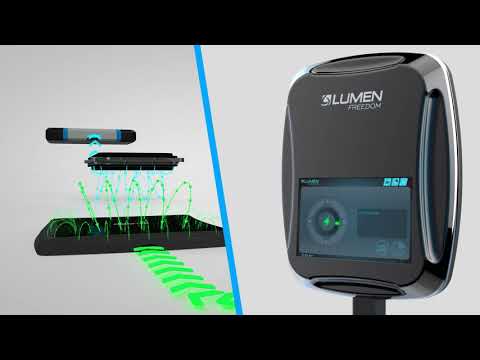The Device Chronicle spoke to Software Team Lead Radek Pesina and Rodney Wilson, GM at the Melbourne-based company. Lumen Freedom is revolutionising the world of EV charging by producing a Wireless Electric Vehicle Charging (WEVC) system.
From Static to Dynamic non-stop highway charging, the development and adoption of WEVC makes EV driving even more appealing and eliminates visual urban pollution. WEVC is also an enabler for the future development and uptake of autonomous driving. The technology has become very high profile so much so that it has been adopted by Tier 1 automotive already – McLaren Automotive for the Speed Tail Hyper-GT performance supercar. Lumen, the team proudly says, is the first company to have UL, IEC and SCC certification. Rodney says Lumen is heavily committed to expansion beyond Australia with key markets being Sweden, China, US, and the UK.
The WEVC technology enables wireless charging from a wall box to a ground pad which transmits power through the air gap to a vehicle mounted receiving pad. There are 3 charging variants; Static (Parking bays), Semi Dynamic (Taxi Ranks and traffic lights) and fully dynamic where a vehicle can be charged without stopping during freeway driving at speeds in excess of 100 kph.

Starting the WEVC journey
Lumen Freedom’s GM Rodney Wilson explains how the company started out on this great EV adventure. In 2016, Rodney explains that the company went through an exhaustive due diligence study to ascertain the feasibility of the technology. At that time a 2-box reference sample was provided from the then licensor and Lumen Freedom proceeded to take this design to the next level and designed the first 11KW Single-box system. Rodney says “The outcome was a product half the size of the original box and was the most advanced wireless charging system in the world.” During the ongoing development stages, Witricity, from Boston, acquired the original patent portfolio and now Lumen Freedom is a fully accredited Licensee of Witricity. USA. There are 2 coil topologies Double D (DD) and Single Coil (SC). Lumen follows the double-D topology but can provide either coil topology to meet all customer requirements. The good news for the sector is that the two systems are interoperable.
Technology offering
Radek describes the Lumen wireless charging system. Starting from the wall-mounted current source, power is provided to the ground pad which transmits the electric current in a magnetic field across an air gap onto a receiving pad on the vehicle. It then takes that current, converts it and transfers it to the battery management system of the vehicle which then manages the charge into the battery. There is a communication system between the wallbox and vehicle that communicates via Wi-Fi. Radek uses the analogy “It is similar technology to the induction cooker or mobile phone charging system. It has a 92% efficiency and compares favorably in this regard to a plug-in charger”.
Use case scenarios supported by WEVC
So, what are the emerging use cases for the WEVC technology? Rodney admits that plug-in chargers will of course have their place in the ecosystem but that a lot of city planners are expressing a desire not to have “ugly” plug-in charging bays along the roadways intruding into the city landscape. There are further challenges associated with plug-ins. Radek explains that if you have offset plug-in chargers in the parking bays, then you must carry the charging cable across the vehicle’s roof to the other side of the vehicle. People with disabilities may not be able to use them. There are a lot of restrictions on parallel parking spaces in cities. The municipalities need to buy expensive plots of land for parking bays with plug-in charging stations. There are also the risks of vandalism and copper theft from the charging stations. Radek adds a very important point to consider: “A fully autonomous vehicle needs a wireless charger.”
Uptake is gradual
Rodney and Radek describe a gradual uptake of the technology in Australia. In the UK, a consortium in Nottingham and Leeds is testing the technology for taxi ranks with a possible wider uptake across the greater London area in the next 2+ years, supported by a consortium of city councils with private sector involvement Lumen Freedom was awarded the tender to provide the hardware to the consortium. The US is also advanced, and Rodney says that Lumen is involved with some big players in the mobility, Energy and infrastructure space. Rodney admits there are other competitor systems on the horizon but there is enough business potential for everyone. “WEVC is seamless, low maintenance and the only alternative unless there is a revolutionary energy source available. Wireless charging will be the step change for the EV car industry”. Rodney sees a future of “snack charging“ all through the community, an additional benefit is for the driver to come home with a full battery in the evening and provide Vehicle to Grid and Vehicle to Home energy from the excess storage of power available from the vehicle battery. The new power stations could soon be large apartment blocks with 200 to 300 cars in them all returning energy to the grid from their vehicle.
Infrastructure first, offerings second
Rodney and Radek admit that the charging Infrastructure needs to plan years ahead and protect for the influx of WEVC enabled vehicles to come. “The technology provides a range of safety functions including Living object detection and Foreign object detection which provide advanced human and system protection. In the end vehicles may be wirelessly enabled, allowing the consumer to select when they will go wireless.
Importance of OTA software updates
Robust and secure OTA software updates such as a professional service provided by Mender.io are extremely important for the ground assembly. Radek says there are “a lot of standards still in the works, we know that this is an emerging technology waiting on standards to release. There are going to be continuing releases and updates, alterations for cybersecurity, the protocols, the payment methods may change, high need to ensure the devices are OTA capable and cybersecurity is a huge topic. All vulnerabilities must be patched in real time and there are standards with payment mechanisms included. You will need automated payment systems if you charge when stopped at a red light.”
We wish Radek and Rodney well on their journey to create a more energy efficient and sustainable transportation system.
